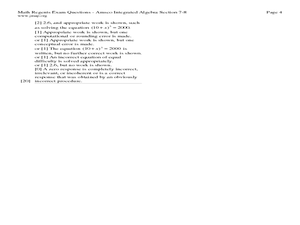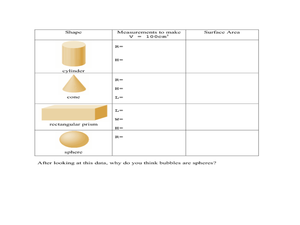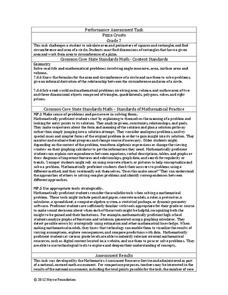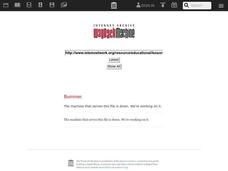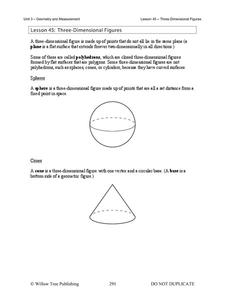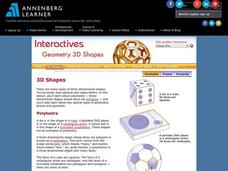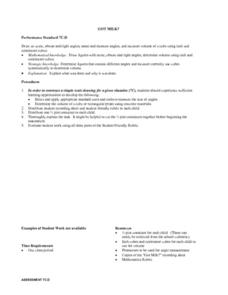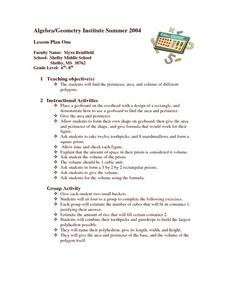Curated OER
Twenty Volume Of Solids Problems
In this volume worksheet, students solve twenty volume of various solids problems. The solids examined include: cylinders, cubes, rectangular prism, including how the volumes of these figures change with increased in length. The...
Curated OER
Why are Bubbles Spheres
Students calculate the surface area of different polygons. In this geometry lesson, students practice calculating the volume of spheres. They work with cones, cylinders and rectangular prisms.
Curated OER
Solid Shapes- Reteaching Worksheet
In this solid shapes reteaching learning exercise, 1st graders review solids in a box at the top of the page. They see examples of a sphere, cone, cylinder, cube, and a rectangular prism. They circle the objects with the same shape as...
Curated OER
Properties of 3-D Shapes
In this properties of 3-D shapes worksheet, students fill in a chart that describes 5 shapes such as a cube, a rectangular prism, and a cylinder. They tell if the shape is a prism, and how many faces, edges, and vertices it has.
Curated OER
Build Solids
In this solid figures worksheet, students use the figures for the cube, pyramid, and rectangular prism to answer the six questions about the characteristics of solid figures.
Curated OER
Making Nets for Solids
Third graders are introduced to a variety of two-dimensional shapes. Individually, they are given a cube, cylinder and cone and take apart each shape. While taking them apart, they discuss how the two-dimensional shape was created.
Noyce Foundation
Pizza Crusts
Enough stuffed crust to go around. Pupils calculate the area and perimeter of a variety of pizza shapes, including rectangular and circular. Individuals design rectangular pizzas with a given area to maximize the amount of crust and do...
Curated OER
Measurement
Students create two prisms out of the same paper. They calcuate the number of centimeter cubes needed to fill each prism. They discover the concept of volume.
Curated OER
Volume and Surface Area
Students explore volume and surface area. In this math instructional activity, students fill boxes with cubes to identify the volume of the boxes. Students discuss area.
Curated OER
Collecting the Rays
Students investigate the affect shape has on the ability of a solar panel to collect sunlight. In this collecting sunlight using a solar panel lesson, students determine which solar panel shape collects the most sunlight. Students use...
Willow Tree
Three-Dimensional Figures
Time to move into the third dimension! Learn the names of the geometric solids and count faces, edges, and vertices. Then learn to recognize nets that create a given solid.
Annenberg Foundation
Geometry 3D Shapes: 3D Shapes
Explore vocabulary related to three-dimensional shapes. An instructional website describes the characteristics of different geometric solids. Learners can use an interactive component to view nets, faces, vertices, and edges of common...
CCSS Math Activities
Smarter Balanced Sample Items: 6th Grade Math – Claim 2
They claim there are problems on the assessment. The presentation provides 13 questions that demonstrate the problem-solving claim for Smarter Balanced assessments. Teachers use the resource to provide examples of problem-solving...
Curated OER
Got Milk?
Students measure the angles of a milk carton. They identify and label acute, right, and obtuse angles. Using appropriate tools, students determine the volume of a cube or a rectangular prism. Students complete worksheets to...
Curated OER
Lesson One: Perimeter, Area, Volume
Students explore perimeter, area and volume. Using geoboards, toothpicks, and marshmallows, students create specific shapes. They are directed to use formulas to find the volume, area, and perimeter of the created shapes. In groups,...
Curated OER
State of NY Testing Program
In this algebra worksheet, students review geometric and algebraic concepts for the state exam at the end of the year. They discuss factoring and volumes, prisms and measuring. There are over 16 pages of questions on this lesson.
Curated OER
Naming 3-D Figures
In this 3-D figure worksheet, students name a set of 4 figures: cylinder, cube, sphere and rectangular prism. An answer key is included.
Curated OER
Finding Volume
In this volume worksheet, students are given the equations for finding the volume of a cube and the volume of a prism. They solve two multi-part problems finding the volumes of different solids.
Curated OER
Color It
In this shape recognition worksheet, students follow the instructions as they color cylinders, spheres, cones, cubes, and prisms the appropriate colors. Students also respond to a short answer question.
Curated OER
Drawing Patterns For Solids
In this patterns activity, 4th graders look at 2 solids, a cone and a cube, and then circle the multiple choice letter of the net for each solid.
Curated OER
Identify Shapes and Matching Parts
Students identify real world objects as shapes they have learned. In this 3-D shapes worksheet, students identify shapes such as a cube for a box, a sphere for a globe, and a cylinder for a soup can.
Curated OER
Surface Area
Students calculate the surface area of cubes, solids and cylinders. In this geometry lesson, students define the surface area formulas for different prisms. They calculate the surface area with 100%, and 80% accuracy.
Curated OER
Volume of a Stair-Step
Sixth graders calculate the volume of a stair-step. In this volume lesson, 6th graders apply their knowledge of the formula for finding volume. They practice their use of math language since this lesson is presented in a Japanese...
Curated OER
New Boxes from Old
Ninth graders take a rectangular box (e.g., a cereal box) and cut it up to make a new, cubical box with the same volume as the original. In so doing, they will discover that because the cubical box has less surface area than the...


